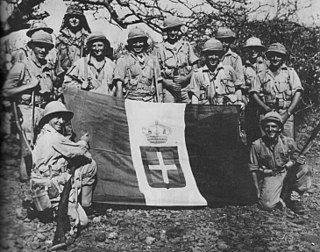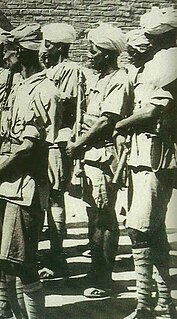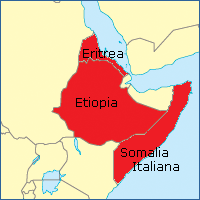 W
WItalian East Africa was an Italian colony in the Horn of Africa. It was formed in 1936 through the merger of Italian Somalia, Italian Eritrea, and the newly occupied Ethiopian Empire, conquered in the Second Italo-Ethiopian War.
 W
WThis article lists the Governors-General of Italian East Africa, a colony of the Italian Empire from 1936 to 1941.
 W
WThe 40th Infantry Division "Cacciatori d’Africa" was an infantry division of the Italian Army during World War II. It was formed 27 July 1940 and dissolved 15 May 1941. The divisions Cacciatori d’Africa and 65 Infantry Division Granatieri di Savoia were outside of the normal chain of command, being subordinated directly to Prince Amedeo, Duke of Aosta., together with other colonial troops in Italian East Africa.
 W
WPrince Amedeo, 3rd Duke of Aosta was the third Duke of Aosta and a first cousin, once removed of the King of Italy, Victor Emmanuel III. During World War II, he was the Italian Viceroy of Italian East Africa.
 W
WThe Asmara President's Office is the building, in Italian neoclassical style, where the President of Eritrea lives and rules the country.
 W
WThe Asmara-Massawa Cableway was a cableway built in Italian Eritrea before World War II.The Eritrean Ropeway, completed in 1937, ran 71.8 km from the south end of Asmara to the city-port of Massawa..
 W
WBands was in Italian military term for irregular forces, composed normally of foreigners or natives, with some Italian officers and NCOs in command. These units were employed by the Italian Army as auxiliaries to the regular national and colonial military forces. They were also known to the British colonial forces as "armed Bands".
 W
WThe Battle of Gondar or Capture of Gondar was the last stand of the Italian forces in Italian East Africa during the Second World War. The battle took place in November 1941, during the East African Campaign. Gondar was the main town of Amhara in the mountains north of Lake Tana in Ethiopia, at an elevation of 7,000 ft (2,100 m) and had an Italian garrison of 40,000 men, commanded by Generale Guglielmo Nasi.
 W
WThe Cinema Impero is an Art Deco-style cinema in Asmara, the capital of Eritrea. It was built in 1937 by the colonial authorities in Italian Eritrea.
 W
WRosa Dainelli was an Italian doctor from Cuveglio who was working in Ethiopia during World War II, when the British liberated East Africa from Italian occupation in the Horn of Africa and returned it to the Ethiopian Empire. She actively participated in sabotage campaigns against the British Army.
 W
WThe East African campaign was fought in East Africa during the Second World War by Allies of World War II, mainly from the British Empire, against Italy and its colony of Italian East Africa, between June 1940 and November 1941. The British Middle East Command with troops from the United Kingdom, South Africa, British India, Uganda Protectorate, Kenya, Somaliland, West Africa, Northern and Southern Rhodesia, Sudan and Nyasaland participated in the campaign. These were joined by the Allied Force Publique of Belgian Congo, Imperial Ethiopian Arbegnoch and a small unit of Free French.
 W
WItalian Ethiopia, also known as the Italian Empire of Ethiopia, was an Italian formal entity of the territory of the conquered Ethiopian Empire. Italian Ethiopia was not an administrative entity, but the formal name of the former territory of the Ethiopian Empire which now constituted the Governorates of Amhara, Harar, Galla-Sidamo, and Scioa after the establishment of Italian East Africa
 W
WFaccetta Nera is a popular marching song of Italy's Fascist regime. It was written by Renato Micheli with music by Mario Ruccione in 1935.
 W
WThe Gondrand massacre was a 1936 Ethiopian attack on Italian workers of the Gondrand company. It was publicized by Fascist Italy in an attempt to justify its ongoing conquest of Ethiopia.
 W
WRodolfo Graziani, 1st Marquis of Neghelli, was a prominent Italian military officer in the Kingdom of Italy's Regio Esercito, primarily noted for his campaigns in Africa before and during World War II. A dedicated fascist, he was a key figure in the Italian military during the reign of Victor Emmanuel III.
 W
WThe Italian invasion of British Somaliland was part of the East African campaign (1940–1941) in which Italian, Eritrean and Somali forces of Fascist Italy entered British Somaliland and defeated its combined garrison of British, Commonwealth and colonial forces supported by Somali irregulars. The Italian victory was based on mobility and speed but was hampered by the terrain, rainy weather and British resistance.
 W
WThe Italian African Police, was the police force of Italian North Africa and Italian East Africa from 1 June 1936 to 1 December 1945.
 W
WThe Italian guerrilla war in Ethiopia was a conflict fought from the summer of 1941 to the autumn of 1943 by remnants of Italian troops in Ethiopia and Somalia, in a short-lived attempt to re-establish Italian East Africa. The guerrilla campaign was fought following the Italian defeat during the East African Campaign of World War II, while the war was still raging in Northern Africa and Europe.
 W
WThe First Italo-Ethiopian War was fought between Italy and Ethiopia from 1895 to 1896. It originated from the disputed Treaty of Wuchale, which the Italians claimed turned Ethiopia into an Italian protectorate. Full-scale war broke out in 1895, with Italian troops from Italian Eritrea having initial success until Ethiopian troops counterattacked Italian positions and besieged the Italian fort of Mekele, forcing its surrender.
 W
WThe Second Italo-Ethiopian War, also referred to as the Second Italo-Abyssinian War, was a war of aggression which was fought between Italy and Ethiopia from October 1935 to February 1937. It is seen as an example of the expansionist policy that characterized the Axis powers and the ineffectiveness of the League of Nations before the outbreak of World War II.
 W
WThe Mogadiscio-Villabruzzi Railway is an historical railway system that ran through southern Somalia. It was constructed between 1914 and 1927 by the colonial authorities in Italian Somaliland. The railway connected the capital city Mogadishu with Afgooye, and subsequently with Villaggio Duca degli Abruzzi - usually called "Villabruzzi". The line was later dismantled by British troops during World War II. Plans for re-establishing the railway were made in the 1980s by the Siad Barre administration, but were aborted after the regime's collapse.
 W
WGuglielmo Ciro Nasi was an Italian general who fought in Italian East Africa during World War II.
 W
WOperations on the Northern front, East Africa, 1940 in the Second World War, were conducted by the British in Sudan and the Armed Forces Command of Italian East Africa in Eritrea and Ethiopia. On 1 June 1940, Amedeo, Duke of Aosta the Viceroy and Governor-General of the Africa Orientale Italiana, commander in chief of the Armed Forces Command of the Royal Italian Army and General of the Air Force, had about 290,476 local and metropolitan troops and by 1 August, mobilisation had increased the number to 371,053 troops. General Archibald Wavell, General Officer Commanding-in-Chief (GOC-in-C) of Middle East Command, had about 86,000 troops at his disposal for Libya, Iraq, Syria, Iran and East Africa. About 36,000 troops were in Egypt and 27,500 men were training in Palestine.
 W
WPostage stamps and postal history of Italian East Africa are related to the stamps and their history issued by the Kingdom of Italy between 1936 and 1941 for use in Italian East Africa, called in Italian Africa Orientale Italiana (A.O.I.). A.O.I. was made of Italian Eritrea, Ethiopia and Italian Somalia.
 W
WThe Royal Corps Of Eritrean Colonial Troops were indigenous soldiers from Eritrea, who were enrolled as askaris in the Royal Corps of Colonial Troops of the Royal Italian Army during the period 1889–1941.
 W
WOltre Giuba or Trans-Juba was an Italian colony in the territory of Jubaland in present-day southern Somalia. It lasted for one year, from 1924 until 1925, when it was absorbed into Italian Somaliland. Trans-juba is the former name of Jubaland, a federal member state of Somalia.
 W
WYekatit 12 is a date in the Ethiopian calendar which refers to the massacre and imprisonment of Ethiopians by the Italian occupation forces following an attempted assassination of Marshal Rodolfo Graziani, Marquis of Negele, Viceroy of Italian East Africa, on February 19, 1937. Graziani had led the Italian forces to victory over the Ethiopians in the Second Italian invasion of Ethiopia and was supreme governor of Italian East Africa. This has been described as the worst massacre in Ethiopian history.